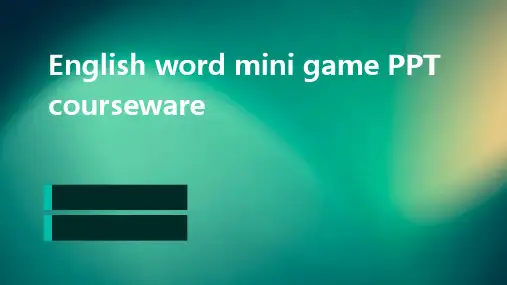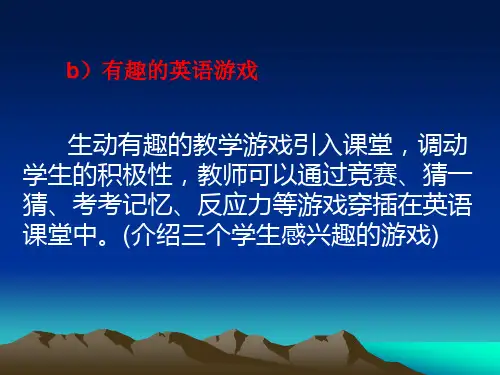新版幼儿园英语游戏合辑教学课件ppt
- 格式:ppt
- 大小:20.54 MB
- 文档页数:20
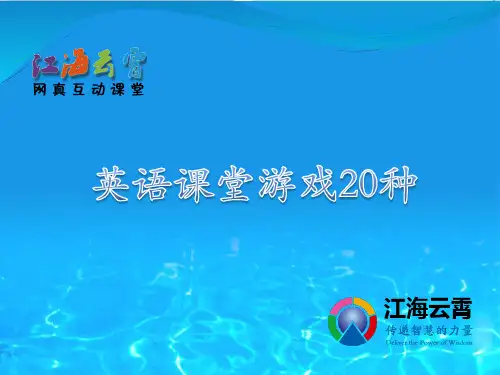
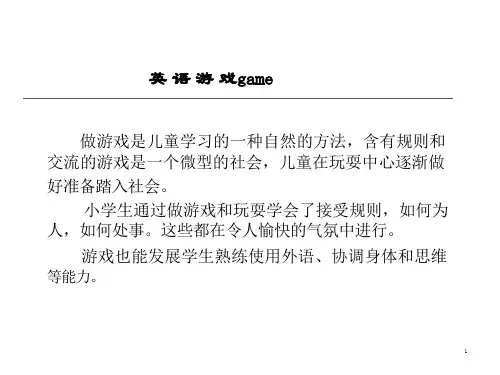
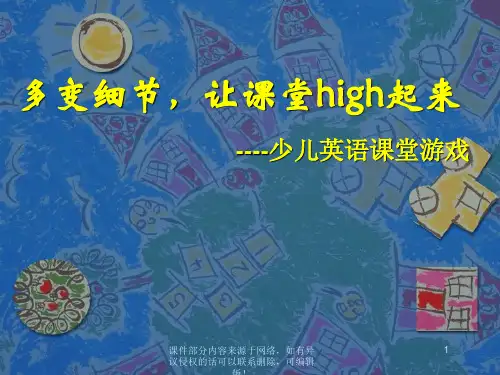
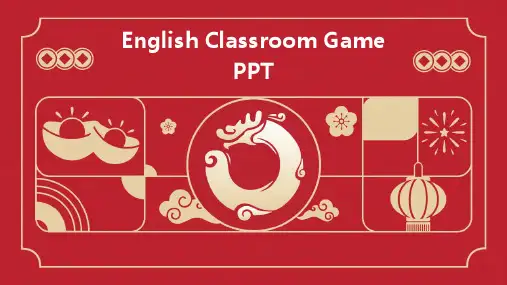
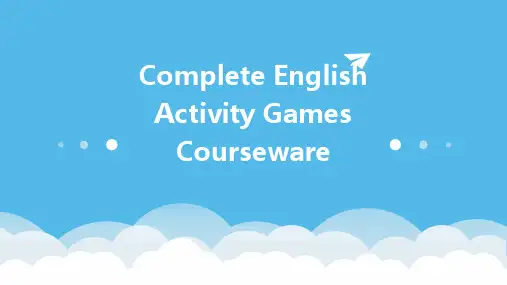
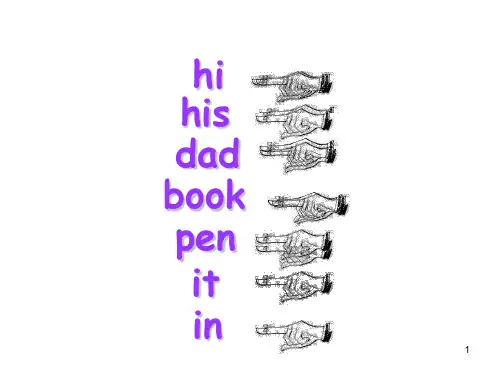
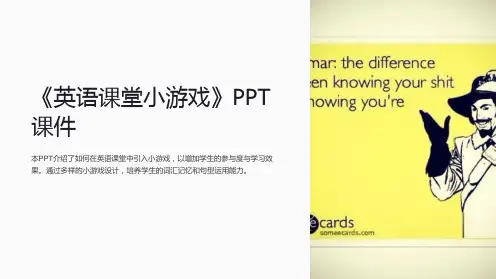
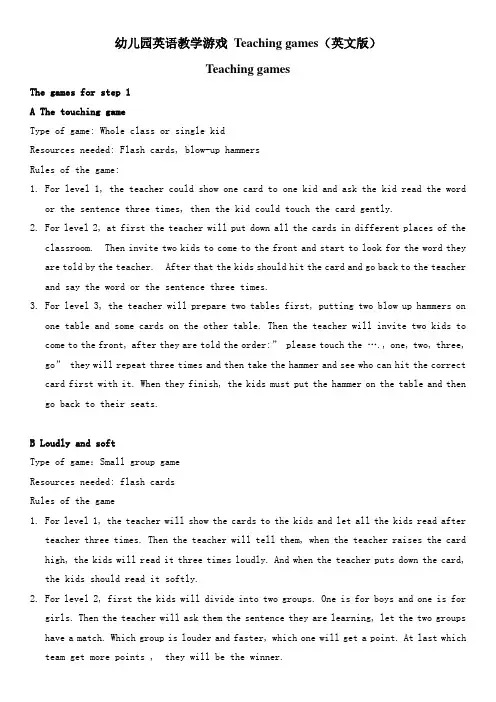
幼儿园英语教学游戏Teaching games(英文版)Teaching gamesThe games for step 1A The touching gameType of game: Whole class or single kidResources needed: Flash cards, blow-up hammersRules of the game:1.For level 1, the teacher could show one card to one kid and ask the kid read the wordor the sentence three times, then the kid could touch the card gently.2.For level 2, at first the teacher will put down all the cards in different places of theclassroom. Then invite two kids to come to the front and start to look for the word they are told by the teacher. After that the kids should hit the card and go back to the teacher and say the word or the sentence three times.3.For level 3, the teacher will prepare two tables first, putting two blow up hammers onone table and some cards on the other table. Then the teacher will invite two kids to come to the front, after they are told the order:” please touch the …., one, two, three, go” they will repeat three times and then take the hammer and see who can hit the correct card first with it. When they finish, the kids must put the hammer on the table and then go back to their seats.B Loudly and softType of game:Small group gameResources needed: flash cardsRules of the game1.For level 1, the teacher will show the cards to the kids and let all the kids read afterteacher three times. Then the teacher will tell them, when the teacher raises the card high, the kids will read it three times loudly. And when the teacher puts down the card, the kids should read it softly.2.For level 2, first the kids will divide into two groups. One is for boys and one is forgirls. Then the teacher will ask them the sentence they are learning, let the two groups have a match. Which group is louder and faster, which one will get a point. At last which team get more points , they will be the winner.3.For level 3, the teacher could change the actions. For example, the teacher will tellthe kids tapping the face means say the sentence loudly and touching the face means say it softly.C The fruit gameType of game: Small group gameResources needed: cardsRules of the game:Divide your class into groups of two or three. Give each team one name. Such as: Apple Team, Orange Team, Banana Team, Pear Team and so on. Then teacher takes one card and begin the game. Eg: Teacher says: “Apple” Little kids crouch and say: “apples down, apples down, apples down then bananas down.”Then this team points another team to do like this. Thing to consider:1.This game is suitable for large or middle kids in the kindergarten.2.Crouching can be changed to different actions, such as swinging, jumping, etc.D Traffic lightsType of game: Small group gameResources needed: Flash cards, two pieces of paper (one has a picture of a red light; the other has a picture of a green light drawn on it), blindfold,Rules of the game:1.First the teacher will tell all the kids to stand up and make a circle, inviting a kidto come to the centre of the circle with a blindfold on.2.When the kid in the centre says, “green light”, all the other kids will walk aroundthe circle, at the same time repeating the target language sentence, such as, “I like ice cream” or “I like bread”. The content of the target language will be based on the flash card that the teacher holds up for the students to see.3.But when the kid says, “red light”, all the kids must stop and squat down quietly. Thekid in the centre will try to tag somebody. When he/she touches somebody, all the other kids should ask, “What do you like?” The one who was tagged will answer according to the card. All the kids repeat the same sentence three times.4.Change the kid in the circle. Continue the game.Things to consider:This game is only suitable for the kids of level 2 and level 3. Monitor the game well to make sure the student who tags others does it gently and avoids hitting others in the face. Demonstrate how you want the students to tag others.To make the activity more fun you can ask the students to hop around the circle, fly around, swim around… Keep in mind safety and classroom furniture or other hazards when letting the students be more active.E The train gameType of game:Small group gameResources needed: cardsRules of the game:First, the teacher drive the train to be the locomotive, drive the train to the front of a child. The teacher asks: “What’s your name?” Children say three times:”My name is~~.”After the children draws the teacher's clothes on the small train. The teacher and children drive the train to the front of second child .Then the second child say three times :”My name is~~.” The second child who answers right and loudly can pull the first child clothes on the train. Go on to ask, until make a long train.Notice:1. A small child asked to answer the question can only number can be less 4-8 people.2. In the army of the children can ask their children to read the sentence. The t rain can be a little more, the number of 6-10 people.3. In the army of the children can play several groups of people at the same time. At the same time, each group chooses a child to be the locomotive. The teacher in charge of children answers and asks.F Raising the cardsType of game: Group work or pair workResources needed: Flash cardsRules of the game:1. For level 1, the teacher should divide all the kids into three groups, and put down different cards in front of the three groups. When the teacher says the word loudly according to the card of group 1, all the kids of group 1 have to repeat it three times and stand up with their own arms rising. Then continue this game by using the card fromgroup 2 and then group 3.2. For level 2, the teacher can invite 6---8 kids to the front and stand behind them. Each kid should hold one card. After the teacher walks to one kid’s back, all the other kids will say the word or sentence showing on his/her hand three times. Then the kid who is holding the card should raise the card and say it loud as soon as possible. If the kid doesn’t do this he/she needs to go back to his/her seat. The one who is the last one to go back is the winner.3. For level 3, the teacher should invite 6---8 kids come to the front and face back to the other kids. Each kid need hold one card. At first, all the other kids will ask a question, and the teacher should point at one kid. Then he/she should turn around and show the card to them, at this moment all the other kids should say the sentence three times together. When the 6---8 kids finished, they can act as a little teacher, showing the card to each kid sitting on the chairs and ask a question, and the kids sitting on the chairs have to answer the question according to the different cards. At last, the teacher should collect the cards and the new game goes on.G Colorful footprintsType of game: small group gameResources needed: Flash cards, different colour footprintsGame rules for level 11.The teacher will put down different colored footprints on the floor. The number offootprints will be determined by the colors the students are learning.2.The teacher invites 4---6 kids to come to the front. The teacher then shows the kids atthe front of the class a flashcard, and asks them with the help of all the other kids, “What color is it?” First, the 4---6 kids answers the teacher three times, then look for the same color footprints on the floor and quickly put their own foot on it. This game could be dangerous if children run into each other or stomp on each other’s feet. Encourage the children to be careful, to look out for others and not to run or stomp on others. Also, you can make giant colored feet, so students can stand on it together, you can make many little feet of the same color so that they all have their own colored foot to stand on, or you can put a small colored foot in the middle of a hula-hoop and the students can place one foot into the hoop not directly into the colored foot.Game rules for level 2 and 3 (This can be done as a relay)1.The teacher puts all the footprints on the floor in one line.2.Divided the kids into two groups and line them up in two lines at in front of the lineof colored feet, with one line of students on one side of the footprints and the other line of students on the other side. When the teacher says, “One two three, go!” The first kid at the front of each line starts jumping along the footprints. The two kids will be jumping side by side with the colored feet in between them.3.The teacher and the other kids will ask, “What color is it?” continuously. The kidswho are jumping will answer according to the color of the footprints. They keep jumping to the next one and then the next one calling out the color each time. After they finish all the footprints, they run back and must clap hands with the second kid in their own group.4.The game continues until all the members of the same team finish. The team, who is faster,is the winner.Make sure the kids don’t just jump from foot to foot without saying the correct target language. Space the feet out so that the students don’t have to jump too far each time. Demonstrate to the students how to jump down their lane and then return on the same side to their waiting team mate. If the students in line are not behaving well, sit them down and only let the jumping students stand.H Throwing the diceType of game:Group work or whole class gameResources needed: Flash cards, a big diceRules of the game:1. For level 1, teacher should prepare a big dice before the class, sticking six cards on different sides. At the beginning of the class, the teacher should lead all the kids to learn the six words and sentences. The teacher throws the big dice, and then asks: what do you see? (or some other questions). All the kids need to answer it three times according to the picture on the top side of the dice. Next round, the teacher should invite one kid to throw the dice, then the teacher and all the other kids should answer it.2. For level 2, the teacher can mark the number 1---6 on the six sides of the dice. Prepare 6 flash cards and number them from 1 to 6. At the beginning of the class, the teacher should lead all the kids to learn six words and sentences together. Then the teacher throws the dice first, after it falls down, the kid needs to choose the picture from the teacheraccording to the number on the top side of the dice. And teacher asks:”what do you see?”The kid answers the question. At the same time all the other kids must repeat after him/her three times.3. For level 3, the teacher should mark the number 1---6 on the six sides. At the beginning of the class, the teacher should lead all the kids to learn the six words and sentences. Then the teacher needs to write down six old sentences on the black board. Then the teacher throws the dice, after it falls down, the kid should choose the sentence according to the number on the top side of the dice. And asks all the other kids, all of the kids should answer it three times or after the dice falls down, the number on the top side is 5, all the kids should repeat the sentence five times.I Clapping my handsType of game: Pair work or the whole classResources needed: Flash cardsRules of the game:1.For level 1, first the teacher does a demo, clap hands twice, and then clap legs twice.Then the teacher organizes all the kids to do the same actions. When they are familiar with the actions, the teacher will ask them to say ‘ It’s a book. ’ at the same time of clapping hands. When they clap the legs, say nothing.2.For level 2, first the teacher does a demo, clap hands twice, and then clap legs twice.Then the teacher organizes all the kids to do the same actions. When they are familiar with the actions, the teacher asks the kids ‘What’s this’ at the same time of clapping hands. When all the kids clap the legs, they should answer ‘It’s a book. ’ And then the game goes on.3.For level 3, firstly the teacher orders the kids to count 1, 2, 1, 2… then asks all theNo. 1 kids to stand up, shake their hands and sit down. After this, the teacher asks all the No. 2 kids to stand up, jump and sit down. Then all No.1 kids have to make pairs with the person who is on the right. In each pair, both of them have to clap their own hands when they ask questions. During answering, both of them have to clap their partner’s hands.The games for step 2A The guessing gameType of game:Whole class or group workResources needed: flash cardsRules of the game1.For level 1, the teacher will show the card to all the kids first and ask them repeatthree times. Then teacher will put down all the cards on the floor, and put the last card facing down. The teacher will request all the kids to read the words or sentence which they are learning three times, when they see the last card the teacher asks all the kids to guess what it is. After this, put the card on the first place and put the last card facing down. Go on the game.2.For level 2, firstly the teacher will review all the flashcard, then show part of theflash card which is covered with a white paper and ask all the kids to guess what it is.Also the teacher could divide all the class into 3 groups, inviting one by one group to attend the game.3.For level 3, the teacher marks all the cards with number of 1---6, then put the cardsfacing down. Let all the kids or one group of kids guess what the No 1 card is and then No 2,…B Turn and shoutType of game:Group game or pair workResources needed: Flash cardsRules of the game:1.For level 1, first, the teacher should invite two kids to come to the front and give eachof them a flash card to hold in front of their bodies.Then ask them to stand back to back.When teacher says ‘1, 2, 3, go’, the two kids need to start slowly walking forward.After the teacher and all the other kids finish saying the question three times, the two kids should turn all around and shout out the sentence according to their partner’s card.2.For level 2, the teacher should invite two groups of kids to the front. And give a cardto one of the kids in each group. Then follow the same rules as No 1 above.3.For level 3, the kids should put the cards on their own back as the teacher and the otherkids say the question sentence three time, the kids with cards on their backs should turn around and around. When the teacher and other students stop talking, the two kids should shout out the sentence according to their partner’s card.C Whispering gameType of game:group gameResources needed: Flash cardsRules of the game:The teacher should first let all the kids sit in a semicircle, and then divide them into two groups.The teacher should then invite the first kid of each group to come to the front and tell them a sentence, phrase or a word. (This should depend on the range of ages and levels) When the teacher says, one two three go! The two kids will go back and tell the next kid in their group.Finally, the last kids from each group will come to the front and speak out what they’ve heard.D What’s the next one?Type of game:Group game or whole class gameResources needed: Flash cardsRules of the game:1.The teacher will show all the flash cards one by one to the kids, and review them withall the kids.2.The teacher put all the cards on the floor or the blackboard that all the cards are facingdown.3.The teacher divides all the kids into three groups, first the teacher will ask the kidsof group 1, what’s this? The kids of the group 1 answer together by guessing the first card This is a … At this time, the teacher will pick up the first card. And then the group 1 will ask the kids of group 2, and the kids of group 2 answer it by guessing the second card. Then the kids of group I and 2 ask group 3, the group 3 answers. At last, all the kids ask the teacher, and the teacher answers.E Changing chairsType of game: Whole class gameResources needed: flash cardsRules of the game:Have all the students sit in a circle or semicircle with the teacher standing in the middleholding a pile of flash cards. The teacher reveals one of the cards that they are holding and asks the students, “What do you like?” The students answer according to the picture on the card. The teacher then says, “One two three, change!” The students stand up and then exchange seats. At this point the teacher enters the game and sits down in a seat, causing one student to miss out on a getting a new seat. This student then takes a different card from the teacher, shows it to the class and asks three times, “What do you like?”The class answer three times according to the flash card. Once again the teacher calls out, “One two three, change!” The game continues for as long as the teacher decides. The teacher can give other instructions or change the sentence pattern according to the lesson objectives. Such as only students wearing red can change seats…Things to consider:This game can be played without the teacher stealing a chair. The teacher can create a game atmosphere and let the students compete for the chairs. If the teacher is not involved in stealing the chairs then they will need to choose someone each round to start, or they need to reduce the students’ chairs by one to begin with.If the language content is too difficult for the junior class, then make it easier for them and only have the students repeat the sentence, don’t require them to practice the question sentence at the same time.The senior level students should practice both the sentence and the questions for each round.F Pick up peasType of game: small group gameResources needed: Flash cards, colourful peasRules of the game1.The teacher will put down many colorful peas on the table and floor, and then put somebaskets on the table.2.The teacher will invite 6---8 kids to come to the front and will show them a flash card.After the teacher asks, “What color is it?” the kids must answer three times, for example, “It’s red, it’s red, it’s red.” The teacher will then say, “One, two, three, go”, the students take a basket and start to pick up the same color peas as shown on the flash card. When the teacher and other students finish saying the sentence It’s red five times, all the kids should stop picking up peas and put down their basket. The teacher will showa new card to the kids and repeat the activity.3.After several times, the game is over, all the kids should count how many peas they haveand tell the other kids.4.Change to another 6---8 kids, and continue the game. Make sure the students pay attentionto any furniture in the room and other students. If playing with peas on the floor, there is a risk that students might bump their heads together if they rush or bend down to pick up the same pea or basket. To avoid this you can start the students in different places or have them start from a squatting position, so they can’t move too quickly and they won’t blindly bend down. Place the baskets around the room and use lots of peas so they all have enough to collect close to their position. If playing at a table, space the students around the table and make them aware of each others’ fingers. Anyone who is grabbing too roughly or too quickly can be told to sit out the game. Demonstrate how you want them to collect peas in a safe manner before starting the game.G The bomb gameType of game: Group work or the whole classResources needed: Flash cardsRules of the game:1.For level 1, the teacher shows all the cardsand marks one card (as a bomb). The teacherpoints to the cards by order. Have all the kids read. Explain to the kids whenever they see this marked card they should keep quiet.Note: teacher should show a demo before the whole class are ready to do it.2.For level 2, the teacher shows all the cards and then marks one or two cards. Explainto the kids whenever they see this marked card they should keep quiet. Before doing the game, the teacher should divide all the kids into two groups. For the first time, the kids of group 1 act as teachers, they should ask group 2. Group 2 answer the question according to the card which is pointed by the teacher. Then exchange. Group 2 act as the teacher.3.For level 3, the teacher shows all the cards and marks one or two cards. Explain to thekids whenever they see this marked card they should say:”Mom, mom I love you” three times. Before doing the game, the teacher should divide all the kids into three groups.Firstly, each of the first kid from the three groups can be invited to attend the game.When they heard the other kids’ question, they must answer it as soon as possible, and the quickest one can get one point for his own group. And then continue the game. Finally,the group gets the highest score will be the winners.The games for step 3A Name fourType of game:group gameResources needed: Flash cardsRules of the game:First the teacher and all the kids will ask something they have learned.For example: “What animals do you like?”Then the teacher will ask one kid to stand up and answerKid 1: “I like cats.”All the other kids should repeat three times.Secondly, the teacher and all the kids should ask the same question. Invite kid 2.Kid 2: I like cats and dogs.All the other kids should repeat three times.Then the teacher and all the kids ask the same question and invite kid 3 to answer.Kid 3: “I like cats, dogs and rabbits.”All the other kids will repeat three times.Finally, the teacher and all the kids ask the same question. Invite kid 4 to answer. Kid 4: “I like cats, dogs, rabbits, and tigers.All the other kids should repeat three times.The teacher can change the question. And according to the children’s levels, let the kids ‘Name three’ or ‘Name five’.B .What’s this?Type of the game: whole class; group work; pair workResources needed: flash cards, teacher’s pointerRules of the game:1.For level 1,the teacher should face all the kids and then show themone card and ask them, “What’s this?” Ask all the kids to answer together.2.For level 2, first the kids should be divided into two groups. The teacher will inviteone group to come to the front and act as the teachers, and then ask the other group to come to the front to answer.3.For level 3, the kids should be put into pairs. The No 1 kid acts as a teacher, askingthe No. 2 kid. The No. 2 kid should answer as quickly as they can.C What’s missing?Type of the game: group work; pair workResources needed: flash cardsRules of the game:1.For level 1, the teacher will show all the cards to the kids and put them downon the floor. Then the teacher should ask all the kids to cover their eyes. Once all the kids have their eyes closed, the teacher should take one card away. After this the teacher should let all the kids open their eyes and read the remaining cards with the teacher three times. Finally, the teacher will ask all the kids, “What’s missing?”2.For the level 2 and 3, the kids could be separated into 3 or 5 groups. Theteacher can invite the kids to do the game one group at a time. The teacher may take away one or two cards.D Yes or noType of the game: small group or pair gameResources required: flash cardsRules of the game:Divide the class into two groups. Place two chairs in the front of the class, one chair represents “yes” and the other represents “no”. Ask two students to stand up to compete against each other. The teacher then makes a statement about the flash card, for example they hold up a picture of a yellow balloon and say, “The balloon is yellow”. If the balloon is yellow, then the students race to the “yes” chair. If the balloon is not yellow, they race to the “no” chair. The child who is correct and the first to sit down gains one point for their team. Alternatively, the teacher holds up a flash card and asks a “yes” or “no”question. For example, they hold up a picture of a yellow balloon and ask, “Is this a yellow balloon?” Again the students race to the correct chair. The teacher then asks the next pair of students to play and the game continues.Things to consider:For level 3, the students could be put into 4 teams and set up two pair of chairs for thefour teams to race again each other. But make sure the students are clear which pair of chair they are competing for. For example teams one and two compete for the first pair of chairs, while teams 3 and 4 compete for second pair of chairs.E Wolf is comingType of game:Small group gameResources needed: cardsRules of the game:The teacher takes a flash card in their hand and shows it a group of students and then asks the group of students to stand up. After the teacher shows the students the flash card they should ask the students a question. The students then need to answer the teacher’s question according to the flash card. The students who answer correctly and promptly can take one step forward. The students who are incorrect or too slow to answer cannot take a step forward. The teacher should continue to change the cards as the game continues. When the teacher reveals a blank flash card, the teacher should call out in a loud voice, “Wolf is coming”. The students must then rush back to their seats. The students who are slow t return to their seats must sit out the next round of the game.Things to consider:1.For level 1 kindergarten class, make the groups smaller, between 4 to 6 students pergroup. If the content is too difficult you can have the students merely repeat the answers the teacher gives according to the flash cards2.For level 2, the groups can be larger, between 6 to 8 students per group. Have thestudents ask the teacher questions and then answer according to the flash card.3.If the students are already familiar with this game, you can ask one student to cometo the front to act as the wolf.F Hug gameType of game: Group work or whole classResources needed: flash cardsRules of the game:1.For the level 1, firstly all the kids make a circle and walk around. When the teachershows the flash card to the kids, all the kids should ask the question three times ‘How many … do you see?’ The teacher answers ‘I see 2 birds’. At the same time, 1 kid mustsnuggle up to another kid. The kid with no partner exits and next round, he/she should be with teacher and answer the question ‘I see…’2. For the level 2 and 3, firstly all the kids make a circle and walk around. When the teachershows the flash card to the kids, all the kids should ask the question three times ‘How many … do you see?’ and then all the kids should answer three times ‘I see 2 birds’.After they finish saying the sentence, 1 kid must snuggle up to another kid. The kid with no partner exits.Some of other games:Teacher Says or Simon SaysTeacher gives simple commands. If teacher says ‘Simon says’. you need to do the action. If teacher doesn’t say ‘Simon says’, you don’t need to perform it. If you do it, you will lose and quit the activity. The children who leave the activity at last will be the winners.Passing GamePassing the cards or some papers, when the kid holds the card, he must speak it loudly pass it to the next one.Who is the quickest one?Divide the whole class into three groups. And then invite one kid of each group to the front, after the teacher says a word or a sentence, the kids will touch the card quickly. The quickest one will get one point for the group. And then go on the competition.Duck, duck, gooseBeach Ball GameYou stand in one large circle or several small circles. Teacher names the topic. One child says something about the topic and throws the ball to another child. The one who catches the ball continues this action. Teacher may change the topic every few minutes Example:Teacher: What fruit do you like? Child A: I like apple.Child A: What fruit do you like? Child B: I like banana.Child B: What food do you like? Child C: I like bread.If there is a large class, the teacher could prepare 2 or 3 balls for the kids and play the game at the same time.。

